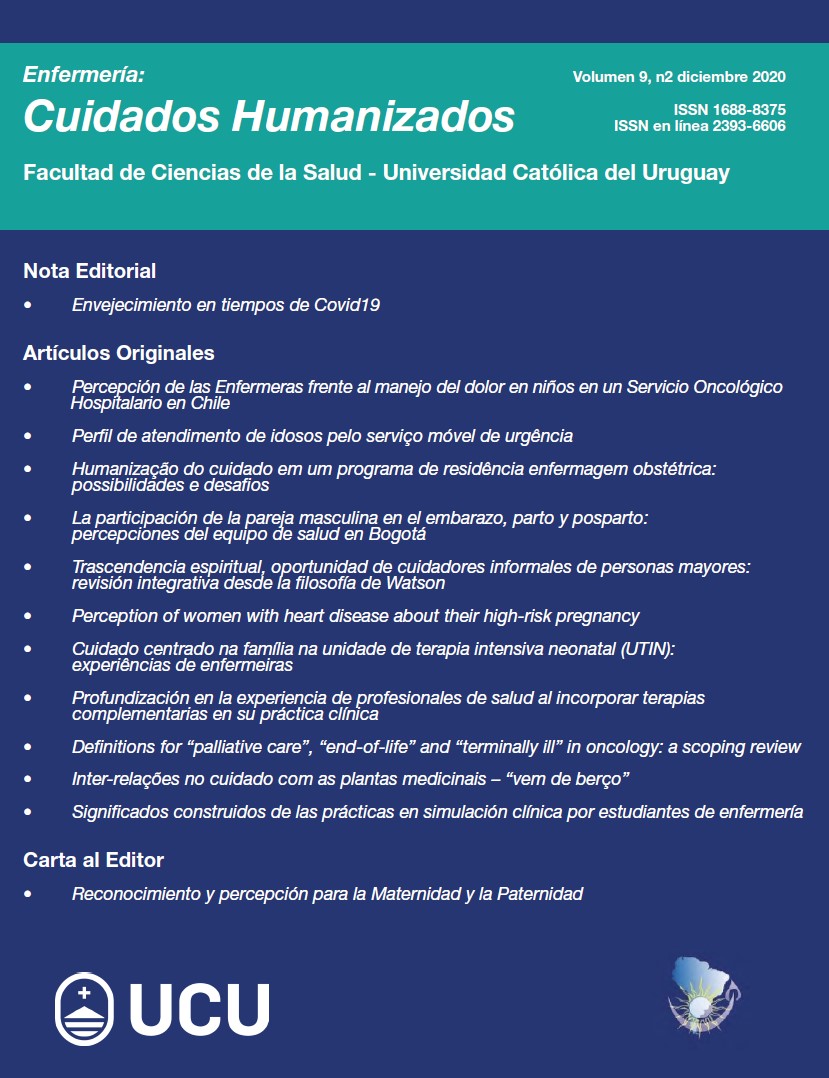Definiciones para “cuidados paliativos”, “final de vida” y “enfermedad terminal” en oncología: scoping review
DOI:
https://doi.org/10.22235/ech.v9i2.2317Palabras clave:
Cuidados paliativos, enfermedad critica, cuidados paliativos al final de la vida, oncología médica, investigación cualitativaResumen
Objetivo: Identificar y mapear las definiciones de cuidados paliativos, fin de vida y enfermedad terminal en la literatura en oncología. Materiales y método: scoping review basada en los supuestos del Joanna Briggs Institute. Se analizaron 51 artículos originales, publicados entre 2012 y 2017, indexados en las bases de datos Pubmed, Web of Science y Scopus. Se consultaron los sitios web de 25 sociedades de cuidados paliativos de los países mejor clasificados en The Economist's Quality of Death Ranking. Los datos fueron analizados a través de estadística descriptiva y se resumieron por temas, en este caso, las definiciones. Resultados: enfermedad terminal se trata de una enfermedad con tiempo de vida que oscila entre horas y meses; hay un empeoramiento clínico; deterioro funcional y la presencia de metástasis. Los cuidados paliativos tienen por propósito la calidad de vida y la dignidad. El final de la vida comprende el período de hasta 12 meses antes de la muerte. Conclusiones: se ha construido síntesis y definiciones para los conceptos investigados, siendo posible contribuir para adopción de un lenguaje estandarizado en los cuidados e investigaciones junto a los pacientes oncológicos en fin de vida.
Descargas
Citas
Hui D, Nooruddin Z, Didwaniya N, Dev R, de La Cruz M, Kim SH, et al. Concepts and definitions for ‘‘Actively Dying,’’ ‘‘End of Life,’’ ‘‘Terminally Ill”,‘‘Terminal Care”, and ‘‘Transition of Care’’: A systematic review. J Pain Symptom Manage. 2014; 47: 77-89. DOI: https://doi.org/10.1016/j.jpainsymman.2013.02.021
Shigeko I, Hiroko N, Chihoko S, Emiko I. Defining end-of-life care from perspectives of nursing ethics. Nursing Ethics. 2012; 5: 608-618. DOI: https://doi.org/10.1177/0969733011436205
Hui D, Mori M, Parsons HA, Kim SH, Li Z, Damani S, et al. The Lack of Standard Definitions in the Supportive and Palliative Oncology Literature. J Pain Symptom Manage. 2012; 43:582-592. DOI: https://doi.org/10.1016/j.jpainsymman.2011.04.016
Bell C, Nielsen MK, Neegaard MA, Guldin MB, Jensen AB. Remaining lifetime after recognition of terminal illness depends on diagnosis: a nationwide population-based cohort study. J Pain Symptom Manage. 2017; 53:116–123. DOI: https://doi.org/10.1016/j.jpainsymman.2016.08.002
Wright AA, Zhang B, Leating NL, Week JC, Prigerson HG. Associations between palliative chemotherapy and adult cancer patients’ end of life care and place of death: prospective cohort study. BMJ. 2014;348:g1219. DOI: https://doi.org/10.1136/bmj.g1219
Peters MDJ, Godfrey C, McInerney P, Baldini Soares C, Khalil H, Parker D. Scoping Reviews. In: Aromataris E, Munn Z, eds. Joanna Briggs Institute Reviewer's Manual. The Joanna Briggs Institute, 2017. Available from: https://wiki.joannabriggs.org/display/MANUAL/Chapter+11%3A+Scoping+reviews . Accessed Oct 21, 2019.
The Economist. The quality of death: ranking end-of-life care across the world 2015. 2015. Available from: <http://www.lienfoundation.org/sites/default/files/2015%20Quality%20of%20Death%20Report.pdf>. Accessed July 21, 2019.
Franken LG, Masman AD, Winter BCM, Baar FPM, Tibboel D, Gelder T, et al. Hypoalbuminaemia and decreased midazolam clearance in terminally ill adult patients, an inflammatory effect? Br J Clin Pharmacol. 2017; 83(8): 1701 – 12. DOI:
https://doi.org/10.1111/bcp.13259
Franken LG, Masman AD, de Winter BCM, Koch BCP, Baar FPM, Tibboel D, et al. Pharmacokinetics of morphine, morphine-3-glucuronide and morphine-6-glucuronide in terminally ill adult patients. Clin Pharmacokinet. 2016; 55(6): 697 – 710. DOI: https://doi.org/10.1007/s40262-015-0345-4
Franken LG, Mathot RAA, Masman AD, Baar FPM, Tibboel D, van Gelder T, et al. Population pharmacokinetics of haloperidol in terminally ill adult patients. Eur J of Clin Pharmacol 2017; 73(10):1271 – 77. DOI: 10.1007/s00228-017-2283-6
Tang ST, Liu TW, Liu LN, Chiu CF, Hsieh RK, Tsai CM. Physician-patient end-of-life care discussions: correlates and associations with end-of-life care preferences of cancer patients - a cross-sectional survey study. Palliat Med. 2014; 28(10): 1222 – 30. DOI: https://doi.org/10.1177/0269216314540974
Tang ST, Chen JS, Chou WC, Chang WC, Wu CE, Hsieh CH, et al. Longitudinal analysis of severe anxiety symptoms in the last year of life among patients with advanced cancer: relationship with proximity to death, burden, and social support. J Nat Compr Canc Netw. 2016; 14(6): 727 – 34. DOI: https://doi.org/10.6004/jnccn.2016.0074
Tang ST, Wen FH, Hsieh CH, Chou WC, Chen JS, Chiang MC. Preferences for Life-Sustaining Treatments and Associations With Accurate Prognostic Awareness and Depressive Symptoms in Terminally Ill Cancer Patients' Last Year of Life. J Pain Symptom Manage. 2016; 51(1): 41 – 51. DOI: https://doi.org/10.1016/j.jpainsymman.2015.08.006
Tang ST, Wen FH, Chang WC, Hsieh CH, Chou WC, Chen JS, et al. Preferences for life-sustaining treatments examined by Hidden Markov Modeling are mostly stable in terminally ill cancer patients’ last six months of life. J Pain Symptom Manage. 2017; 54(5): 628 – 36. DOI: https://doi.org/10.1016/j.jpainsymman.2017.07.042
Miljković MD, Emuron D, Rhodes L, Abraham J, Miller K. “Allow natural death” versus “do not resuscitate”: What do patients with advanced cancer choose? J Palliat Med. 2015; 18(5): 457 – 60. DOI: https://doi.org/10.1089/jpm.2014.0369
Yan Ho AH, Car J, Ringo Ho MH, Tan-Ho G, Choo PY, Patinadan PV, et al. A novel Family Dignity Intervention (FDI) for enhancing and informing holistic palliative care in Asia: study protocol for a randomized controlled trial. Directory of Open Access Journals. 2017; 18(1): 1 – 12. DOI: https://doi.org/10.1186/s13063-017-2325-5
Mowll J, Lobb EA, Lane L, Lacey J, Chochinov HM, Kelly B, et al. A preliminary study to develop an intervention to facilitate communication between couples in advanced cancer. Palliat Support Care. 2015; 13: 1381 – 90. DOI: https://doi.org/10.1017/S1478951514001333
Houmann LJ, Chochinov HM, Kristjanson LJ, Petersen MA, Groenvold M. A prospective evaluation of dignity admitted to palliative care. Palliat Med 2014; 28(5): 448 – 458. DOI: https://doi.org/10.1177/0269216313514883
Belanger E, Tetrault D, Tradounsky G, Towers A, Marchessault J. Accuracy and usefulness of the Palliative Prognostic Index in a community setting. Int J Palliative Nurs. 2015; 21(12): 602 – 5. DOI: https://doi.org/10.12968/ijpn.2015.21.12.602
Chang YJ, Kwon YC, Lee WJ, Do YR, Lee KS, Kim HT, et al. Buedens, needs and satisfaction of terminal cancer patients and their caregivers. Asian Pac J Cancer Prev. 2013; 14(1): 209 – 15. Disponible en: http://journal.waocp.org/?sid=Entrez:PubMed&id=pmid:23534725&key=2013.14.1.209
Lee MK, Lee WJ, Do YR, Lee KS, Jung KH, Heo DS, et al. Changes in health-related quality of life and quality of care among terminally ill cancer patients and survival prediction: multicenter prospective cohort study. Palliat Support Care. 2015; 13(4): 1103 – 11. DOI: https://doi.org/10.1017/S1478951514000960
Kao CY, Hung YS, Wang HM, Chen JS, Chin TL, Lu CY, et al. Combination of initial Palliative Prognostic Index and Score Change Provides a better prognostic value or terminally ill cancer patients: a six-year observational cohort study. J Pain Symptom Manage. 2014; 48(5): 804 – 14. DOI: https://doi.org/10.1016/j.jpainsymman.2013.12.246
Sinclair S, Macclement S, Raffin-Bouchal S, Hack TF, Hagen NA, Mcconnell S, et al. Compassion in health care: an empirical model. J Pain Symptom Manage. 2016; 51(2): 193 – 203. DOI: https://doi.org/10.1016/j.jpainsymman.2015.10.009
Huang Y, Xi Q, Xia S, Wang X, Liu Y, Huang C, et al. Development and validation of a prognostic scale for hospitalized patients with terminally ill cancer in China. Support Care Cancer. 2014; 22(1): 145 – 52. DOI: https://doi.org/10.1007/s00520-013-1970-9
Ho AHY, Leung PPY, Tse DMW, Pang SMC, Chochinov HM, Neimeyer RA, et al. Dignity amidst liminality: healing within suffering among Chinese terminal cancer patients. Death Studies. 2013; 37(10): 953 – 70. DOI: https://doi.org/10.1080/07481187.2012.703078
Vuksanovic D, Green HJ, Dyck M, Morrissey SA. Dignity therapy and life review for palliative care patients: a randomized controlled trial. J Pain Symptom Manage. 2017; 53(2): 162 – 70. DOI: https://doi.org/10.1016/j.jpainsymman.2016.09.005
Rosenfeld B, Pessin H, Marziliano A, Jacobson C, Sorger B, Abbey J, et al. Does desire for hastened death change in terminally ill cancer patients? Soc Sci Med. 2014; 111: 35 – 40. DOI: https://doi.org/10.1016/j.socscimed.2014.03.027
Kim SY, Kim JM, Kim SW, Shin IS, Bae KY, Shim HJ, et al. Does awareness of terminal status influence survival and quality of life in terminally ill cancer patients. Psycho-Oncology. 2013; 22(10): 2206 – 2213. DOI: 10.1002/pon.3275
Julião M, Oliveira F, Nunes B, Carneiro AV, Barbosa A. Effect of dignity therapy on end-of-life psychological distress in Portuguese patients: a randomized controlled trial. Palliat Support Care. 2017; 15(6): 628 – 637. DOI: https://doi.org/10.1017/S1478951516001140
Walczak A, Butow PN, Tattersall MHN, Davidson PM, Young J, Epstein RM, et al. Encouraging early discussion of life expectancy and end-of-life care: a randomised controlled trial of a nurse-led communication support program for patients and caregivers. Int J Nurs Stud. 2017; 67: 31 – 40. DOI: https://doi.org/10.1016/j.ijnurstu.2016.10.008
Eun Y, Hong IW, Bruera E, Kang JH. Qualitative study on the perceptions of terminally ill cancer patients and their family members regarding end-of-life experience focusing on palliative sedation. J Pain Symptom Manage. 2016; 53(6):1010 – 16. DOI: https://doi.org/10.1016/j.jpainsymman.2016.12.353
Guan NC, Boks MPM, Roes KCB, Zainal NZ, Sulaiman AH, Beng TS, et al. Rapid response to methylphenidate as an add-on therapy to mirtazapine in the treatment of major depressive disorder in terminally ill cancer patients: a four-week, randomized, double-blinded, placebo-controlled study. Eur Neuropsychopharmacology. 2014; 24: 491 – 8. DOI: https://doi.org/10.1016/j.euroneuro.2014.01.016
Peng MT, Liu CT, Hung YS, Kao CY, Chang PH, Yeh KY, et al. Sequential Assessments of the eastern cooperative oncology group performance scale enhance prognostic value in patients with terminally ill cancer receiving palliative care. Am J Hosp Palliat Med. 2014; 33(5): 471 – 6. DOI: https://doi.org/10.1177/1049909114566226
Bovero A, Leombruni P, Miniotti M, Rocca G, Torta R. Spirituality, quality of life, psychological adjustment in terminal cancer patients in hospice. Eur J Cancer Care. 2015; 25(6): 961 – 9. DOI: https://doi.org/10.1111/ecc.12360
Modlińska A, Kowalik B, Buss T, Janiszewska J, Lichodziejewska MN. Strategy of coping with end-stage disease and cancer-related fatigue terminally ill patients. Am J Hosp Palliat Med. 2014; 31(7): 771 – 6. DOI: https://doi.org/10.1177/1049909113503705
Seibel K, Valeo SC, Xander C, Adami S, Duerk T, Becker G. Terminally ill patients as customers: the patient’s perspective. J Palliat Med. 2014; 17(1): 11 – 17. DOI: https://doi.org/10.1089/jpm.2013.0141
Huang KS, Wang SH, Chuad SK, Rau KM, Lin YH, Hsieh MC, et al. The effects of hospice-shared care for gastric cancer patients. Plos ONE. 2017; 12(2): 1 – 10. DOI: 10.1371/journal.pone.0171365
Kwak SM, Choi YS, Yoon HM, Kim DG, Song SH, Lee YJ, et al. The relationship between interleukin-6, tumor necrosis factor-ⲁ, and fatigue in terminally ill cancer patients. Palliat Med. 2012; 26(3): 275 – 282. DOI: https://doi.org/10.1177/0269216311406991
Lloyd-Williams M, Payne S, Reeve J, Dona RK. Thoughts of self-harm and depression as prognostic factors in palliative care patients. J Affect Disord. 2014; 166: 324 – 329. DOI: https://doi.org/10.1016/j.jad.2014.05.029
Ekström M, Johnson MJ, Schiöler L, Kaasa S, Hjermstad MJ, Currow DC. Who experiences higher and increasing breathlessness in advanced cancer? The longitudinal EPCCS study. Support Care Cancer. 2016, 24(9): 3803 – 3811. DOI: https://doi.org/10.1007/s00520-016-3207-1
Ruijs CDM, Kerkhof AJ, van Der Wal G, Onwuteaka-Philipsen B. Symptoms, unbearability and the nature of suffering in terminal cancer patients dying at home: a prospective primary care study. BCM Fam Pract. 2013; 14(1): 201 – 217. DOI: https://doi.org/10.1186/1471-2296-14-201
Preissler P, Kordovan S, Ullrich A, Bokemeyer C, Oechsle K. Favored subjects and psychosocial needs in music therapy in terminally ill cancer patients: a content analysis. BCM Palliat Care. 2016; 15: 48 – 53. DOI: https://doi.org/10.1186/s12904-016-0122-7
Pellizzari M, Hui D, Pinato E, Lisiero M, Serpentini S, Gubian L, et al. Impact of intensity and timing of integrated home palliative cancer care on end-of-life hospitalization in Northern Italy. Support Care Cancer. 2017; 25: 1201 – 07. DOI: https://doi.org/10.1007/s00520-016-3510-x
Bélanger E, Rodríguez C, Groleau D, Légré F, Macdonald ME, Marchand R. Initiating decision-making conversations in palliative care: an ethnographic discourse analysis. BMC Palliat Care. 2014; 13: 63 – 74. DOI: https://doi.org/10.1186/1472-684X-13-63
Krakowsky Y, Gofine M, Brown P, Danziger J, Knowles H. Increasing access - a qualitative study of homelessness and palliative care in a major urban center. Am J Hosp Palliat Med. 2012; 30(3): 268 – 70. DOI: https://doi.org/10.1177/1049909112448925
Naing Soe Y, Amjad NM, Karim KA. Cross-sectional descriptive study of management modalities and quality of surgical patients in a palliative care unit. Medical Journal Malaysia. 2016; 15(1): 35 – 43. Disponible en: https://journals.iium.edu.my/kom/index.php/imjm/article/view/405
Bužgová R, Kozáková R, Sikorová L, Jarošov D. Measuring quality of life of cognitively impaired elderly inpatients in palliative care: psychometric properties of the QUALID and CILD scales. Aging Ment Health. 2012; 21(12): 1287 – 93. DOI: https://doi.org/10.1080/13607863.2016.1220919
MacArtney JI, Broom A, Kirby E, Good P, Wootton J, Yates PM, et al. On resilience and acceptance in the transition to palliative care at the end of life. Health. 2014; 19(3): 263 – 79. DOI: https://doi.org/10.1177/1363459314545696
Wallen GR, Baker K, Stolar M, Miller-Davis C, Ames N, Yates J, et al. Palliative care outcomes in surgical oncology patients with advanced malignancies: a mixed methods approach. Qual Life Res. 2012; 21(3): 405 – 15. DOI: https://doi.org/10.1007/s11136-011-0065-7
Loggers ET, LeBlanc TW, El-Jawahri A, Fihn J, Bumpus M, David J, et al. Pre-transplantation supportive and palliative care consultation for high-risk hematopoietic cell transplant patients. Biol Blood and Marrow Transplant. 2016; 22(7): 1299 – 1305. DOI: 10.1016/j.bbmt.2016.03.006
Parpa E, Kostopoulou S, Tsilika E, Galanos A, Katsaragakis S, Mystakidou K. Psychometric properties of the Greek version of the patient dignity inventory in advanced cancer patients. J Pain Symptom Manage. 2017; 54(3): 376 – 82. DOI: 10.1016/j.jpainsymman.2017.07.002
Guell E, Ramos A, Zertuche T, Pascual A. Verbalized desire for death or euthanasia in advanced cancer patients receiving palliative care. Palliat Support Care. 2015; 13: 295 – 303. DOI: https://doi.org/10.1017/S1478951514000121
Nordly M, Benthien KS, Maase HVD, Johansen C, Kruse M, Timm H, et al, Sjøgren P. The DOMUS study protocol: a randomized clinical trial of accelerated transition from oncological treatment to specialized palliative care at home. BMC Palliat Care. 2014; 13: 44 – 53. DOI: https://doi.org/10.1186/1472-684X-13-44
Fisher K, Seow H, Cohen J, Declercq A, Freeman S, Guthrie DM. Patient characteristics associated with prognostic awareness: a study of a Canadian palliative care population using the InterRAI Palliative Care Instrument. J Pain Symptom Manage. 2015; 49(4): 716 – 25. DOI: 10.1016/j.jpainsymman.2014.08.008
Pereira FMP, Santos CSV. Intial validation of the mini-mental adjustment to cancer (Mini-MAC) scale: study of portuguese end-of-life cancer patients. Eur J Oncol Nurs. 2014, 18(5): 534 – 539. DOI: 10.1016/j.ejon.2014.04.004
Daneault S, Lussier V, Mongeau S, Yalle L, Côté A, Sicotte C, et al. Ultimate journey of the terminally ill: ways and pathways of hope. Can Fam Physician. 2016; 62(8): 648 – 56. Disponible en: https://www.cfp.ca/content/62/8/648.long
O’Brien KK, Colquhoun H, Levac D, Baxter L, Tricco AC, Stratus S, et al. Advancing scoping study methodology: a web-based survey and consultation of perceptions on terminology, definition and methodological steps. BMC Health Serv Res. 2016; 305. DOI: https://doi.org/10.1186/s12913-016-1579-z
Cordeiro FR, Kruse MHL. The right to die and power over life: knowledge to govern the bodies. Texto contexto – enfermagem. 2016; 25: e3980014. DOI: https://doi.org/10.1590/0104-07072016003980014
United Nations Development Program. Human Development Reports [accessed em 21 oct 2019]. Available from: http://hdr.undp.org/en/humandev
United Nations Development Programme. Human Development Indices and Indicators. United States: UNDP; 2018.
Canada.ca. Health Expenditures [accessed em 21 oct 2019]. Disponible en: https://www.canada.ca/en/health-canada/services/health-care-system/reports-publications/health-care-system/canada.html#a7
Canada. Palliative Care in Canada [accessed em 21 oct 2019]. Disponible en: https://www.canada.ca/en/health-canada/services/health-care-system/reports-publications/palliative-care/framework-palliative-care-canada.html#p1.2
Taiwan Academy of Hospice Palliative Medicine. Hospice Palliative Care Act (Natural Death Act) [accessed em 21 oct 2019]. Disponible en: http://www.hospicemed.org.tw/ehc-tahpm/s/w/englishArticle/Hospice_Palliative_Care
Cho YC. From cure to care: the development of hospice care in Taiwan. Hosp Pal Med Int . 2018; 2(5): 286‒87. DOI: 10.15406/hpmij.2018.02.00108
Sullivan A, Steven MS. Economics principles in action. Nova Jersey: Pretince Hall; 2007.
Clark J, Barnes A, Campbell M, Gardiner, C. A Life or “Good Death” Situation? A worldwide Ecological Study of the National Contexts of Countries That Have and Have Not Implemented Palliative Care. J J Pain Symptom Manage. 2019; 57(4):793-801. DOI: https://doi.org/10.1016/j.jpainsymman.2018.12.007
Arias-Casais N, Garralda E, Rhee JY, Lima L de, Pons JJ, Clark D, Hasselaar J, Ling J, Mosoiu D, Centeno C. EAPC Atlas of Palliative Care in Europe 2019. Vilvoorde: EAPC Press; 2019.
Pastrana T, Jüger S, Ostgathe C, Elsner, F, Radbruch L. A matter of definition – key elements identified in a discourse analysis of definitions of palliative care. Palliat Med. 2008; 22(1): 222-32. DOI: https://doi.org/10.1177/0269216308089803
Hui D, Ross J, Parque M, Dev R, Vidal M, Liu D, et al. Predicting in patients with advanced cancer in the last weeks of life: how accurate are prognostic models compared clinicians' estimates? Palliat Med. 2019; 28: 269216319873261. DOI: https://doi.org/10.1177/0269216319873261
Descargas
Publicado
Cómo citar
Número
Sección
Licencia
Derechos de autor 2020 Enfermería: Cuidados Humanizados

Esta obra está bajo una licencia internacional Creative Commons Atribución 4.0.

















